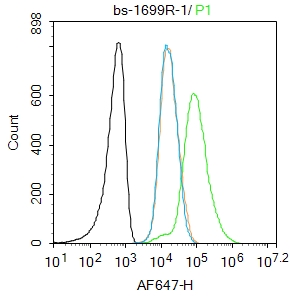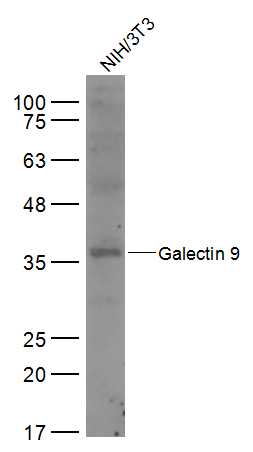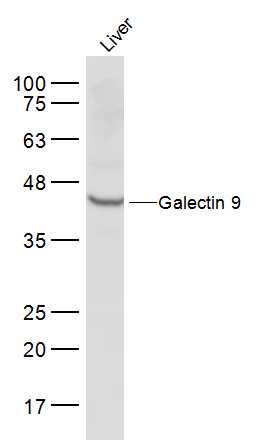Galectin 9 Rabbit pAb
Galectin 9 Rabbit pAb
- SPECIFICATION
- CITATIONS
- PROTOCOLS
- BACKGROUND

Application
| WB |
|---|---|
| Primary Accession | O08573 |
| Reactivity | Mouse |
| Host | Rabbit |
| Clonality | Polyclonal |
| Calculated MW | 40036 Da |
| Gene ID | 16859 |
|---|---|
| Other Names | Galectin-9, Gal-9, Lgals9 |
| Dilution | WB=1:500-2000,Flow-Cyt=1ug/Test |
| Format | 0.01M TBS(pH7.4), 0.09% (W/V) sodium azide and 50% Glyce |
| Storage | Store at -20 ℃ for one year. Avoid repeated freeze/thaw cycles. When reconstituted in sterile pH 7.4 0.01M PBS or diluent of antibody the antibody is stable for at least two weeks at 2-4 ℃. |
| Name | Lgals9 |
|---|---|
| Function | Binds galactosides (By similarity). Has high affinity for the Forssman pentasaccharide (By similarity). Ligand for HAVCR2/TIM3 (By similarity). Binding to HAVCR2 induces T-helper type 1 lymphocyte (Th1) death (By similarity). Also stimulates bactericidal activity in infected macrophages by causing macrophage activation and IL1B secretion which restricts intracellular bacterial growth (PubMed:20937702). Ligand for P4HB; the interaction retains P4HB at the cell surface of Th2 T-helper cells, increasing disulfide reductase activity at the plasma membrane, altering the plasma membrane redox state and enhancing cell migration (PubMed:21670307). Ligand for CD44; the interaction enhances binding of SMAD3 to the FOXP3 promoter, leading to up-regulation of FOXP3 expression and increased induced regulatory T (iTreg) cell stability and suppressive function (PubMed:25065622). Promotes ability of mesenchymal stromal cells to suppress T-cell proliferation (By similarity). Expands regulatory T- cells and induces cytotoxic T-cell apoptosis following virus infection (By similarity). Activates ERK1/2 phosphorylation inducing cytokine (IL-6, IL-8, IL-12) and chemokine (CCL2) production in mast and dendritic cells (By similarity). Inhibits degranulation and induces apoptosis of mast cells (By similarity). Induces maturation and migration of dendritic cells (By similarity). Inhibits natural killer (NK) cell function (PubMed:23408620). Can transform NK cell phenotype from peripheral to decidual during pregnancy (By similarity). Astrocyte derived galectin-9 enhances microglial TNF production (PubMed:25158758). May play a role in thymocyte-epithelial interactions relevant to the biology of the thymus. May provide the molecular basis for urate flux across cell membranes, allowing urate that is formed during purine metabolism to efflux from cells and serving as an electrogenic transporter that plays an important role in renal and gastrointestinal urate excretion (By similarity). Highly selective to the anion urate (By similarity). |
| Cellular Location | Cytoplasm. Nucleus. Secreted {ECO:0000250|UniProtKB:O00182} Note=May also be secreted by a non-classical secretory pathway (PubMed:9038233). Secreted by mesenchymal stromal cells upon IFNG stimulation (By similarity). {ECO:0000250|UniProtKB:O00182, ECO:0000269|PubMed:9038233} |
| Tissue Location | Accentuated expression in liver and thymus of embryo, detected in embryonic heart, brain, lung, liver, and kidney Highly expressed in adult thymus, small intestine, and liver, and to a lesser extent in lung, kidney, spleen, cardiac, and skeletal muscle Barely detectable in brain and reticulocyte. Expressed in placenta, uterus and decidua during pregnancy (PubMed:23242525). Expressed in CD4+ T-cells with higher levels in iTreg cells than other T-cell types and sustained high levels throughout iTreg cell differentiation (at protein level) (PubMed:25065622). Expressed in myeloid cells in lung (PubMed:20937702). Constitutively expressed in microglia (PubMed:25158758). Isoform 1 is expressed exclusively in the small intestine. Isoform 2 expression in decidua increases in pathological pregnancy from gestation day 7.5 to 13.5 and it is higher than in normal pregnancy (PubMed:23242525). Isoform 3 expression in decidua is higher in normal pregnancy than in pathological pregnancy (PubMed:23242525). |

Thousands of laboratories across the world have published research that depended on the performance of antibodies from Abcepta to advance their research. Check out links to articles that cite our products in major peer-reviewed journals, organized by research category.
info@abcepta.com, and receive a free "I Love Antibodies" mug.
Provided below are standard protocols that you may find useful for product applications.
Background
This product as supplied is intended for research use only, not for use in human, therapeutic or diagnostic applications.
If you have used an Abcepta product and would like to share how it has performed, please click on the "Submit Review" button and provide the requested information. Our staff will examine and post your review and contact you if needed.
If you have any additional inquiries please email technical services at tech@abcepta.com.













 Foundational characteristics of cancer include proliferation, angiogenesis, migration, evasion of apoptosis, and cellular immortality. Find key markers for these cellular processes and antibodies to detect them.
Foundational characteristics of cancer include proliferation, angiogenesis, migration, evasion of apoptosis, and cellular immortality. Find key markers for these cellular processes and antibodies to detect them. The SUMOplot™ Analysis Program predicts and scores sumoylation sites in your protein. SUMOylation is a post-translational modification involved in various cellular processes, such as nuclear-cytosolic transport, transcriptional regulation, apoptosis, protein stability, response to stress, and progression through the cell cycle.
The SUMOplot™ Analysis Program predicts and scores sumoylation sites in your protein. SUMOylation is a post-translational modification involved in various cellular processes, such as nuclear-cytosolic transport, transcriptional regulation, apoptosis, protein stability, response to stress, and progression through the cell cycle. The Autophagy Receptor Motif Plotter predicts and scores autophagy receptor binding sites in your protein. Identifying proteins connected to this pathway is critical to understanding the role of autophagy in physiological as well as pathological processes such as development, differentiation, neurodegenerative diseases, stress, infection, and cancer.
The Autophagy Receptor Motif Plotter predicts and scores autophagy receptor binding sites in your protein. Identifying proteins connected to this pathway is critical to understanding the role of autophagy in physiological as well as pathological processes such as development, differentiation, neurodegenerative diseases, stress, infection, and cancer.




